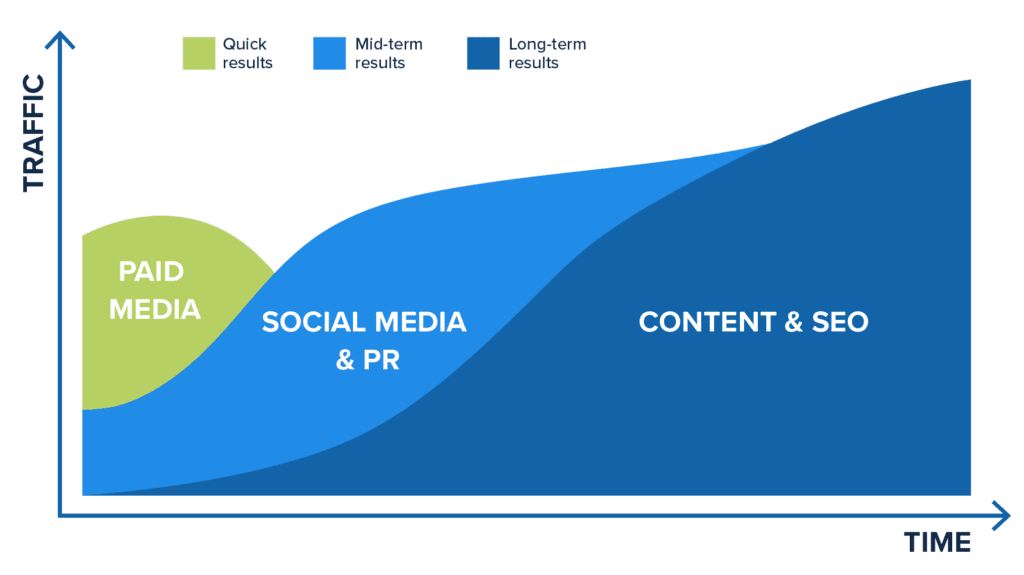B2B (business-to-business) paid media strategy is a distinct marketing practice, separate from its B2C (business-to-consumer) counterpart. While both share some similarities, such as leveraging online platforms for advertising, the nuances between the two can lead to significant differences in approach and outcomes.
Unfortunately, many organizations and agencies fail to grasp these disparities, leading to ineffective B2B paid media campaigns with poor paid search ads and failed goals.
In this article, we’ll delve into some common mistakes and strategy errors encountered in B2B paid media and offer the techniques and strategies you need to succeed.

What is Paid Advertising?
Paid advertising is a digital marketing strategy where selected ads are placed directly in front of predetermined audiences. The payment for online ad space ranges in a variety of mediums. However, it allows businesses to promote their products or services to a targeted audience across various online platforms — in a trackable, fast-paced manner.
Paid advertising encompasses a range of channels, each offering unique opportunities to reach and engage potential customers. Let’s explore some of the key channels within paid advertising.
Paid Search
Paid search advertising involves bidding on keywords relevant to your business and displaying ads at the top of search engine results pages (SERPs) when users search for those keywords. The most popular platform for paid search is Google Ads, which allows advertisers to create text ads that appear alongside organic search results on Google.
With paid search, advertisers can target users actively searching for products or services related to their business. This intent-driven approach ensures that ads are displayed to an audience with a high likelihood of conversion. Additionally, paid search offers advanced targeting options, such as geographic location, device type, and demographics, allowing advertisers to tailor their campaigns to specific audiences.
Display Ads
Display advertising involves placing visual ads, such as banners or multimedia ads, on third-party websites or within mobile apps. These ads can appear in various formats, including static images, animated GIFs, or video ads. Display advertising networks, such as the Google Display Network and Facebook Audience Network, enable advertisers to reach a broad audience across millions of websites and apps.
Display ads are effective for raising brand awareness, driving website traffic, and retargeting users who have previously visited your website. Advertisers can use targeting options, such as interests and demographics, to reach relevant audiences and maximize the impact of their campaigns.
Paid Social Media
Paid social media advertising involves promoting content or ads on social media platforms, such as Facebook, Instagram, X (Twitter), LinkedIn, and Pinterest. These platforms offer sophisticated targeting options based on user demographics, interests, behaviors, and engagement with your brand.
These social media advertising campaigns can take various forms, including sponsored posts, carousel ads, video ads, and lead generation ads. They are highly effective for reaching target customers, driving engagement, and generating leads or sales. Social media marketing allows advertisers to leverage advanced analytics to measure campaign performance and optimize social ads.
Paid Email Marketing
Paid email marketing involves sponsoring emails sent to a targeted list of subscribers to promote products, services, or special offers. Unlike traditional email marketing, where emails are sent from your own email server, paid email marketing utilizes third-party email service providers or advertising platforms to reach a broader audience.
Advertisers can use paid email marketing to target subscribers based on demographics, interests, purchase history, or engagement with previous emails. Advertisers can expand their reach, increase brand visibility, and drive traffic to their website or landing pages. Paid email marketing offers robust tracking and analytics capabilities to measure campaign performance and optimize email content and targeting for better results.
Where Crafting a B2B Paid Media Strategy Goes Bad

Not Knowing Your Budget
Another critical aspect often overlooked in B2B paid media strategy is a lack of clear understanding and planning regarding the marketing budget. Without a well-defined budget, marketers risk either overspending or underutilizing resources, both of which can undermine campaign effectiveness and ROI.
When marketers dive into paid media campaigns without a thorough grasp of their budget constraints, they run the risk of overspending. This can occur due to various factors, such as bidding too aggressively on ad placements, investing in channels that yield low returns, or failing to monitor and adjust spending in real time based on performance metrics. Overspending not only depletes resources unnecessarily but also detracts from the overall profitability of the campaign.
Effective budget planning is essential for optimizing the impact and efficiency of B2B paid media campaigns. It involves carefully assessing available resources and setting clear objectives and priorities to achieve desired outcomes. Establishing a well-defined budget framework allows marketers to make informed decisions about where and how to invest their resources, ensuring maximum return on investment while minimizing wastage and inefficiencies.
Misalignment with Audience Intent
In the realm of B2B paid media strategy, a significant pitfall often arises from a misalignment with audience intent. While B2C audiences might be swayed by impulsive emotions, B2B buyers operate from a different standpoint. They are driven by logical decision-making processes, meticulous research, and a pressing need to address specific business challenges.
Failure to grasp and address these distinct needs can lead to ineffective campaigns that fail to resonate with the intended audience. Understanding the logical, research-driven mindset of B2B buyers is crucial for crafting messaging and campaigns that genuinely engage and compel action.
62% of business buyers say they can develop their selection criteria and/or finalize a vendor list based solely on digital content. This emphasizes the importance of setting an appropriate budget that provides valuable content that resonates with this research-oriented mindset.
Overlooking the Complexity of the Sales Cycle
B2B sales cycles are renowned for their length and complexity, often requiring careful nurturing and cultivation of leads over time. Research indicates that a significant majority of B2B purchases kick off with a referral, underscoring the importance of relationship-building and trust in the B2B landscape.
However, overlooking this reality can lead to shortsighted optimization strategies that prioritize immediate conversions at the expense of long-term relationship building. It’s imperative for B2B marketers to adopt a holistic approach that acknowledges the long-term sales cycle.
Research from HubSpot indicates that 63% of B2B companies were not generating leads from social media. However, these leads are out there. Getting B2B leads from paid social takes a holistic approach that considers every stage of the buyer’s journey.
Neglecting the Power of Targeted Content
Content reigns supreme in B2B marketing, serving as a primary vehicle for educating, engaging, and ultimately converting prospects. However, not all content is created equal, and overlooking the importance of tailoring content to specific buyer personas and stages of the sales cycle can be detrimental.
Effective B2B paid media strategy requires a nuanced understanding of the target audience’s pain points, preferences, and informational needs at each stage of their journey. Craft targeted content that speaks directly to these factors, enhancing relevance, resonance, and ultimately, conversion rates.
A study by Demand Gen Report found that the majority of B2B buyers consider content primarily when evaluating a company and its offerings. Therefore, investing in targeted content that educates, informs, and addresses pain points is crucial for engaging B2B audiences effectively.
Underestimating the Importance of Data and Analytics
Data and analytics serve as the lifeblood of effective B2B paid media strategy. Yet, many organizations and agencies fall short in harnessing the full potential of these resources.
Research by Gartner reveals that only 54% of B2B marketing decisions are being influenced by marketing analytics, indicating a significant gap in utilizing data for optimizing campaigns and allocating resources effectively.
Whether due to inadequate tracking mechanisms, data silos, or a lack of analytical expertise, failing to leverage data effectively can severely hamper campaign performance and ROI.
Successful B2B marketers prioritize robust data collection and interpretation, using insights gleaned to refine targeting, messaging, and campaign optimization efforts continually.
Ignoring the Role of Personalization
Personalization lies at the heart of successful B2B marketing endeavors, enabling brands to cut through the noise and forge genuine connections with prospects. However, many B2B paid media campaigns miss the mark by relying on generic, one-size-fits-all messaging that fails to resonate with individual target accounts.
True personalization goes beyond merely addressing recipients by name; it involves tailoring content, offerings, and interactions to align seamlessly with each prospect’s unique needs and preferences. Personalization allows B2B marketers to drive engagement and, ultimately, foster greater conversion rates.
A survey by Evergage found that 88% of marketers reported measurable improvements due to personalization, underlining its importance in driving engagement and conversions.

Ace Ad Spend With The Professionals
Mastering B2B paid media strategy requires a deep understanding of the unique dynamics and nuances of the B2B landscape. By avoiding common mistakes such as:
- misalignment with audience intent
- overlooking the complexity of the sales cycle
- neglecting targeted content
- underestimating the importance of data and analytics
- and ignoring personalization
… organizations and agencies can elevate their B2B paid media campaigns to new heights of success.
Are you looking to enhance your B2B paid media strategy and achieve greater results? Elevato specializes in crafting tailored, data-driven campaigns that resonate with your target audience and drive meaningful business outcomes. Contact us today to elevate your B2B marketing efforts.
